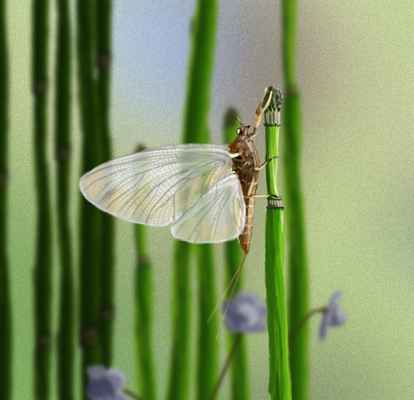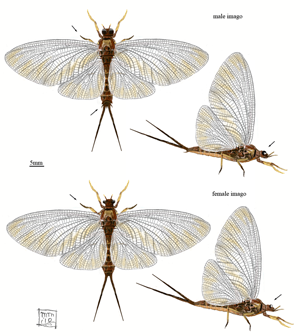home > natural history
Epicharmeropsis hexavenulosus
"six-veinleted beautiful Ephemeropsis"

No species represents the Jehol Biota better than the "giant mayfly" Epicharmeropsis. Previously, this genus had been lumped into the species Ephemeropsis trisetalis, but a 2007 study by Huang and colleagues showed that the Jehol specimens were probably unique. Together with the small minnow Lycoptera, this insect is traditionally a key part of the definition of the Jehol biota.
Epicharmeropsis can be broken down into two species based on the pattern of vains in the wing: E. hexavenulosus and E. quadrivenulosus. E. hexevenulosus is slightly smaller but otherwise would have appeared nearly identical in life. Both were significantly larger than most modern mayflies with a nealy 6 centimetre wingspan and fairly robust bodies. They also had broader wings and much larger hind wings than modern species.
Their nymphs were also unusually large, approaching the size of the Lycoptera fish they're often preserved with. Males and females likewise had few points of difference. The male had shorder middle and hind legs than the female compared to the front legs, had mating claspers on the abdomen and spars on the 9th abdominal segment, and had larger eyes that were more flush with the head than the small, protruding eyes of the female.
Image License:
All rights reserved
DESCRIPTION
Length: 5.5cm (2.2in)
Wingspan: 8cm (3.1 in)
Location: Yixian Formation, Liaoning, China
Time: Aptian age, Early Cretaceous, (125 Ma)
CLASSIFICATION
Kingdom: Animalia
Phylum: Arthropoda
Class: Insecta
Order: Ephemeroptera
Family: Hexagenitidae
Genus: Epicharmeropsis
Species: E. hexavenulosus

Above: Illustration of E. hexavenulosus, pointing out differences between adult male and female specimens.